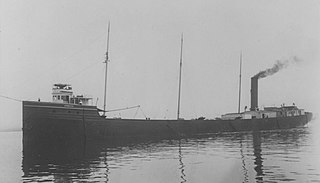
George William Littler Garrett was a British clergyman and inventor who pioneered submarine design.

USS S-26 (SS-131) was an S-class submarine of the United States Navy. She was lost in a collision with a friendly escort ship in late January 1942.

HMS Birkenhead, also referred to as HM Troopship Birkenhead or Steam Frigate Birkenhead, was one of the first iron-hulled ships built for the Royal Navy. She was designed as a steam frigate, but was converted to a troopship before being commissioned.
HMT Warwick Deeping (H136) was a naval trawler of the British Royal Naval Patrol Service during World War II, sunk off the Isle of Wight in October 1940.

Thorsten Nordenfelt, was a Swedish inventor and industrialist.

HMS Affray was a British Amphion-class submarine. It was the last Royal Navy submarine to be lost at sea, on 16 April 1951, with the loss of 75 lives.

Maori was a British refrigerated cargo steamship built in 1893 by C.S. Swan & Hunter of Wallsend-on-Tyne for Shaw, Saville & Albion Co. of London with intention of transporting frozen meat and produce from Australia and New Zealand to the United Kingdom. The vessel stayed on this trade route through her entire career. In August 1909 while on one of her regular trips, she was wrecked on the coast of South Africa with the loss of thirty two of her crew.

HMS Perseus was a British Parthian-class submarine built in 1929 and lost in 1941 during the Second World War. This class were the first to be fitted with Mark VIII torpedoes.

SS Antilla was a Hamburg America Line (HAPAG) cargo ship that was launched in 1939 and scuttled in 1940.

The SS Appomattox was a wooden-hulled, American Great Lakes freighter that ran aground on Lake Michigan, off Atwater Beach off the coast of Shorewood, Wisconsin in Milwaukee County, Wisconsin, United States in 1905. On January 20, 2005 the remnants of the Appomattox were listed on the National Register of Historic Places.

SS Laurentic was a British transatlantic ocean liner that was built in Belfast, Ireland, and launched in 1908. She is an early example of a ship whose propulsion combined reciprocating steam engines with a low-pressure steam turbine. Laurentic was one of a pair of sister ships that were ordered in 1907 by the Dominion Line but completed for the White Star Line. Her regular route was between Liverpool and Quebec City.
Wreck Alley is an area a few miles off the coast of Mission Beach, San Diego, California with several ships intentionally sunk as artificial reefs and as Scuba diving attractions for wreck divers.

PS Portland was a large side-wheel paddle steamer, an ocean-going steamship with side-mounted paddlewheels. She was built in 1889 for passenger service between Boston, Massachusetts, and Portland, Maine. She is best known as the namesake of the infamous Portland Gale of 1898, a massive blizzard that struck coastal New England, claiming the lives of over 400 people and more than 150 vessels.

SS James Eagan Layne was a liberty ship. She was beached and sunk during the Second World War off Whitsand Bay, Cornwall, United Kingdom.

The SS M.M. Drake was a wooden steam barge that towed consorts loaded with coal and iron ore on the Great Lakes. She came to the rescue of the crews of at least 4 foundering vessels in her 19 year career only to meet the same fate in her final rescue attempt. Drake sank in 1901 off Vermilion Point after a rescue attempt of her consort Michigan. Her rudder, anchor, and windlass were illegally removed from her wreck site in the 1980s. They are now the property of the State of Michigan. The rudder is on display as a loan to the Great Lakes Shipwreck Museum and the anchor and windlass are on loan for display to Whitefish Township Community Center. The wreck of Drake is protected as part of an underwater museum in the Whitefish Point Underwater Preserve.

The Hilma Hooker is a shipwreck in Bonaire in the Caribbean Netherlands. It is a popular wreck diving site.
The SS Desabla was built by Hawthorn Leslie & Co. Ltd at Newcastle upon Tyne in 1913 for Bank Line, Glasgow. She was the first oil tanker to join the Bank Line fleet and was chartered and operated for approximately one year by General Petroleum Company along the Pacific coast of the United States, Chile and Canada. In 1914 she was re-chartered to the British Government to transport oil from Texas to the United Kingdom. In 1915 she was torpedoed and sunk by German submarine U-17 off the coast of Scotland.
SS Aquila was a cargo ship built in Britain in 1940 for Stavros Livanos' Trent Maritime Co Ltd. by William Gray & Company. An identical sister, Duke of Athens, was built for Trent at the same time.

The SS Lakeland was an early steel-hulled Great Lakes freighter that sank on December 3, 1924, into 205 feet (62 m) of water on Lake Michigan near Sturgeon Bay, Door County, Wisconsin, United States, after she sprang a leak. On July 7, 2015, the wreck of the Lakeland was added to the National Register of Historic Places.

The SS Atlanta was a wooden hulled Great Lakes steamer that sank in Lake Michigan off the coast of Cedar Grove, Wisconsin, United States, after a failed attempt of her being towed to shore ultimately killing 5 out of her 7 crew members on board. Her wreckage still remains at the bottom of the lake, and on November 6, 2017, the wreck of the Atlanta was listed on the National Register of Historic Places.

















